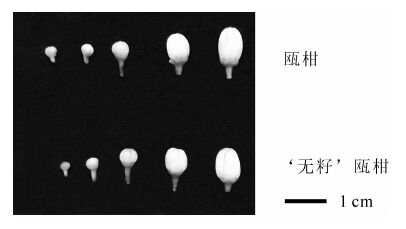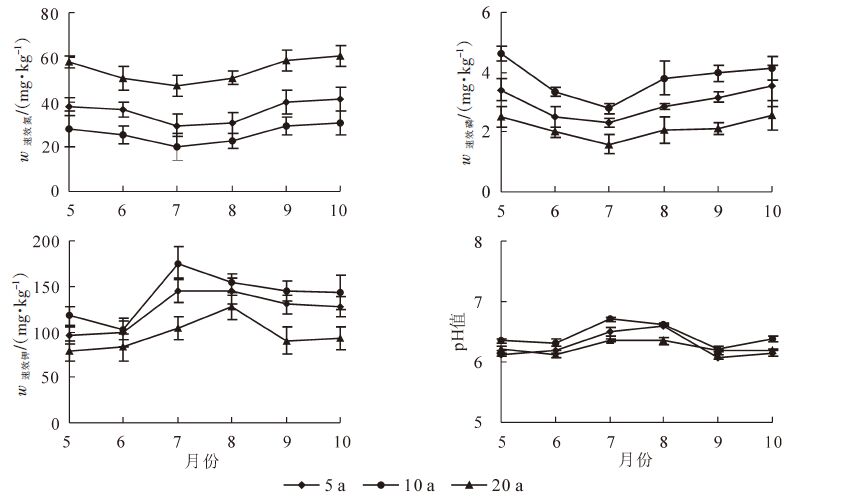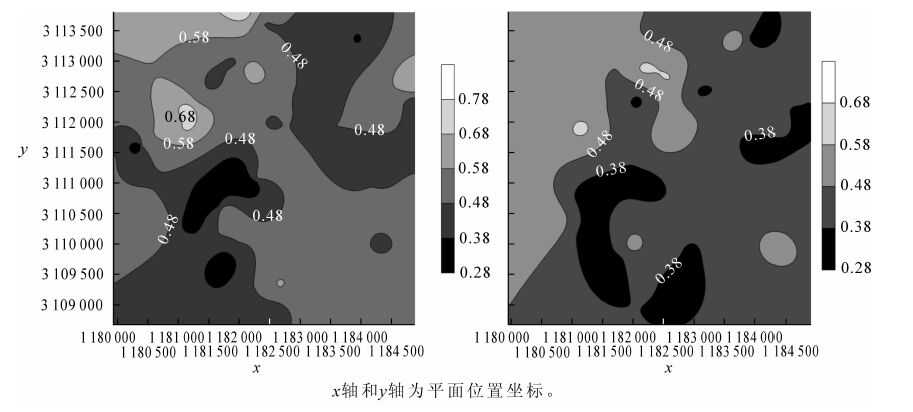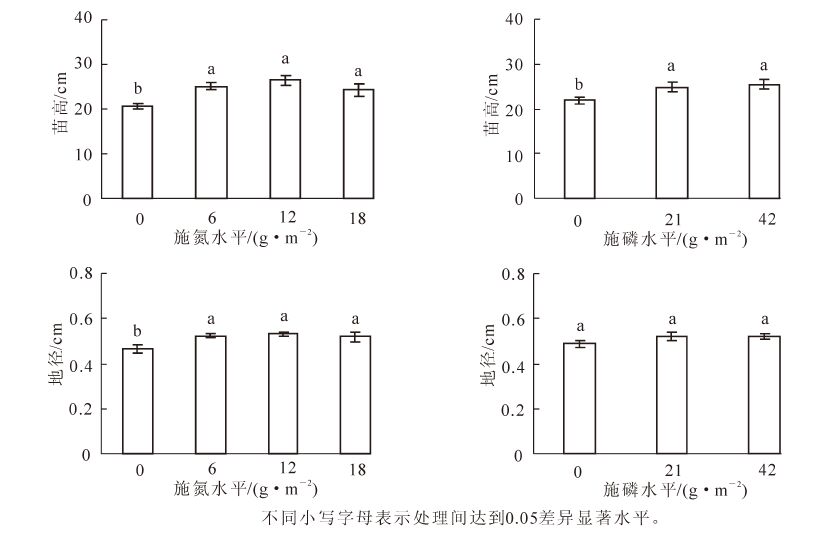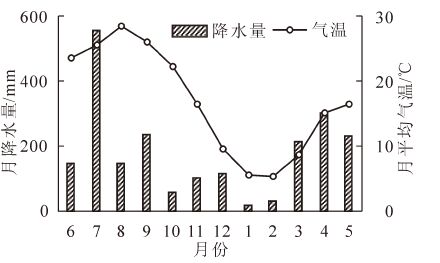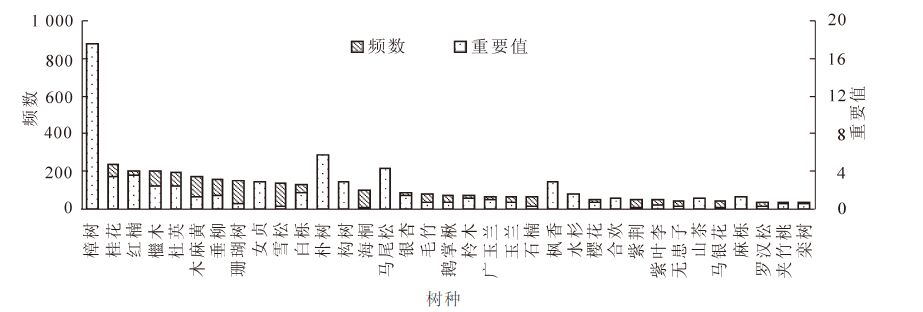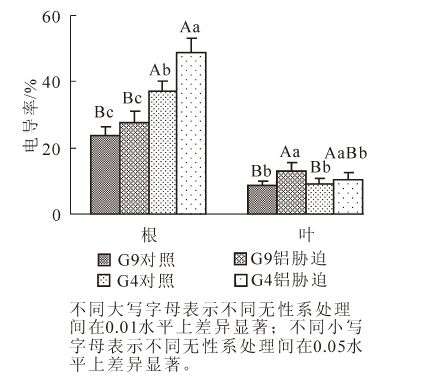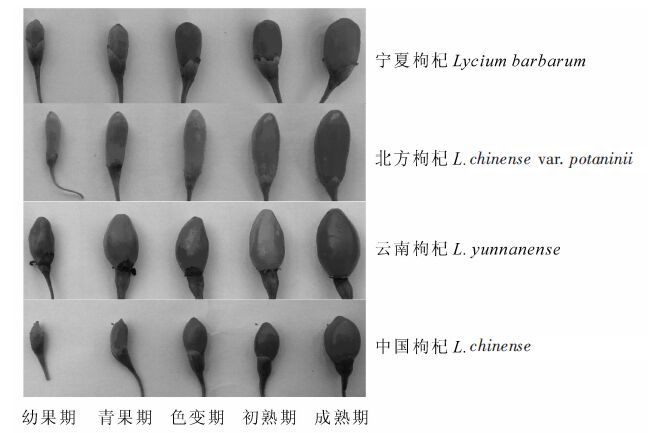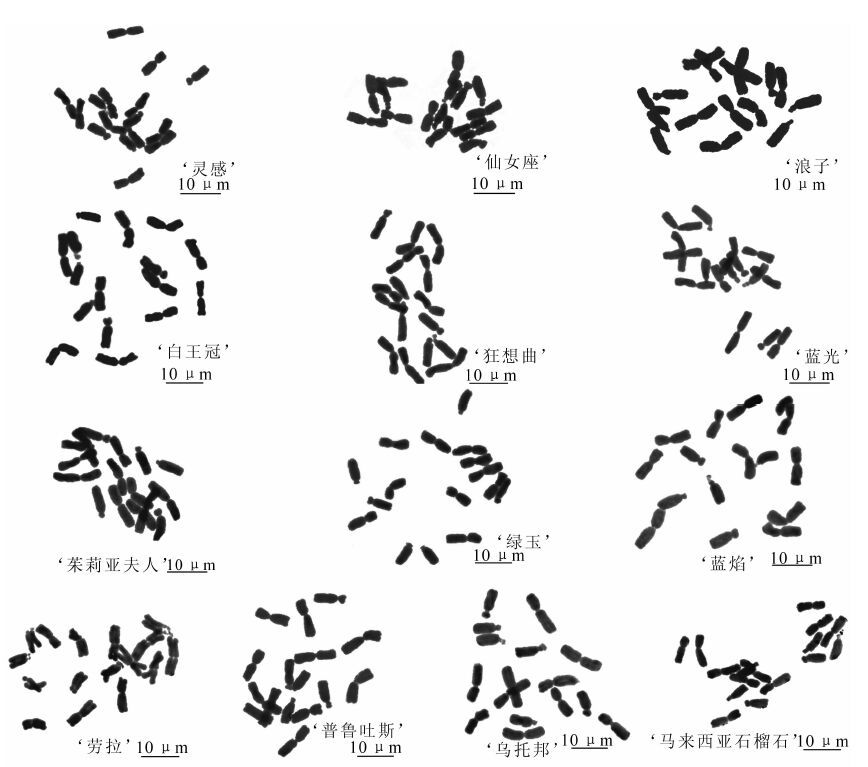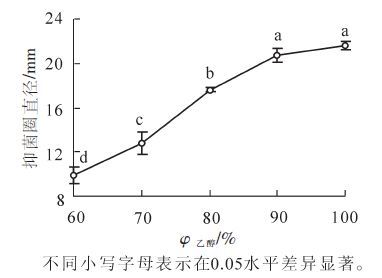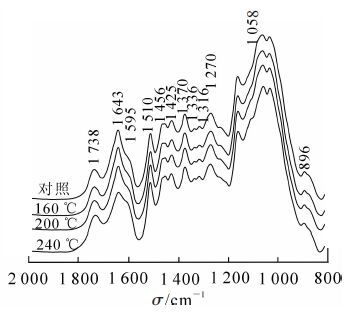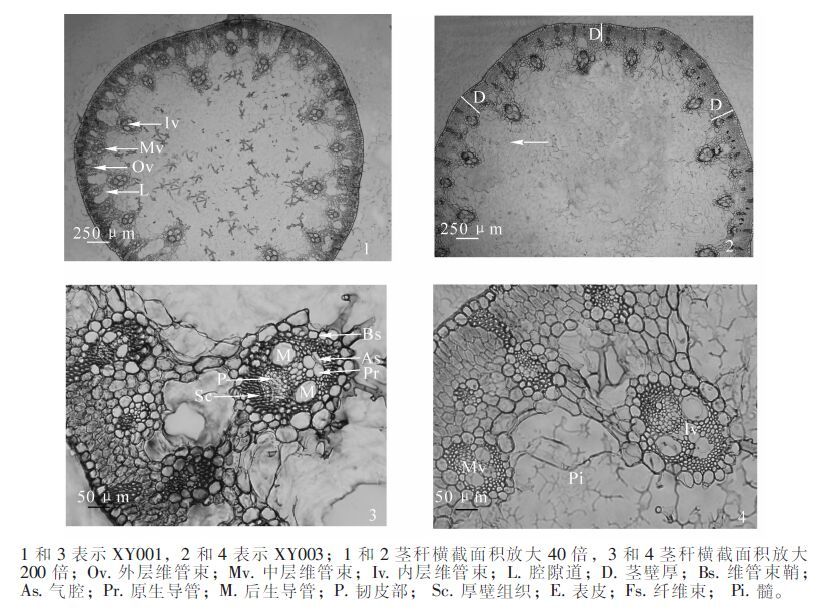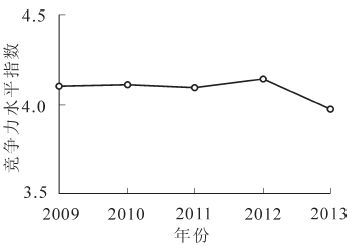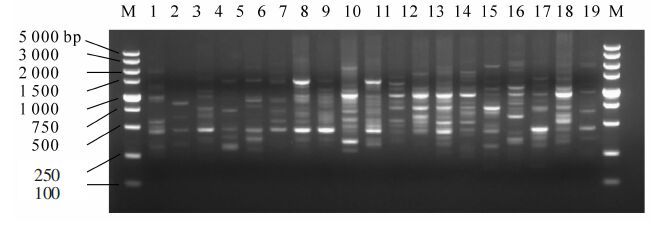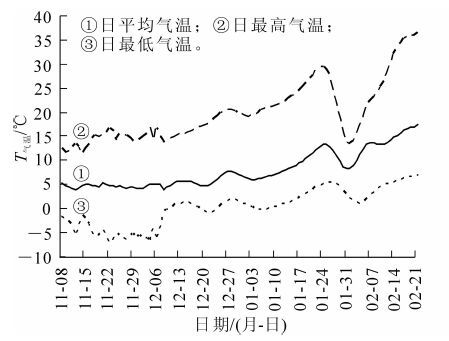2016 Vol. 33, No. 6
2016, 33(6): 921-927.
doi: 10.11833/j.issn.2095-0756.2016.06.001
Abstract:
To obtain the relative expression of two meiosis special genes——RAD51 and MS1 (Male Sterility1),Citrus suavissima ‘Seedless’, a bud variation of its wild type Ougan (Citrus suavissima) with completely aborted pollens that appear abnormally from the tetrad stage, were studied through the molecular mechanism of abnormal meiosis. According to flower bud diameter, five stages of flower buds and anther——pre-meiotic (PM, I), tetrad (T, II), single-celled (SC, III), dual-core (DC, IV), and mature pollen (MP, V)——were collected and each was an composite sample from three trees. An experiment in real-time quantitative polymerase chain reaction (qRT-PCR) was conducted by three replications in each sample and the method of least significant difference(LSD) with SPSS 16.0 was used to test the expression differences between samples under the level of P<0.01. Results showed that expression of RAD51 at Stage I of the anther and the flower buds for C. suavissima ‘Seedless’ was significantly higher (P<0.01) than Ougan. At Stage I of the anther, the relative expression of RAD51 in C. suavissima ‘Seedless’ was 3.7 times higher than in Ougan with MS1 reaching about 300 times higher. However, at Stage I of the flower buds, RAD51 was only 1.1 times higher and MS1 was about 140 times higher. The significantly higher expression of RAD51 at Stage I indicated that a phenomenon of DNA damage might exist in the microsporocyte and tetrad periods of C. suavissima ‘Seedless’; for gene MS1, significantly higher expression of C. suavissima ‘Seedless’ for Stage I also meant that the aborted pollens of C. suavissima ‘Seedless’ had a relationship with the abnormal secretion and transfer of oil lipids that were influenced by disordered expression of MS1.[Ch, 6 fig. 1 tab. 24 ref.]
To obtain the relative expression of two meiosis special genes——RAD51 and MS1 (Male Sterility1),Citrus suavissima ‘Seedless’, a bud variation of its wild type Ougan (Citrus suavissima) with completely aborted pollens that appear abnormally from the tetrad stage, were studied through the molecular mechanism of abnormal meiosis. According to flower bud diameter, five stages of flower buds and anther——pre-meiotic (PM, I), tetrad (T, II), single-celled (SC, III), dual-core (DC, IV), and mature pollen (MP, V)——were collected and each was an composite sample from three trees. An experiment in real-time quantitative polymerase chain reaction (qRT-PCR) was conducted by three replications in each sample and the method of least significant difference(LSD) with SPSS 16.0 was used to test the expression differences between samples under the level of P<0.01. Results showed that expression of RAD51 at Stage I of the anther and the flower buds for C. suavissima ‘Seedless’ was significantly higher (P<0.01) than Ougan. At Stage I of the anther, the relative expression of RAD51 in C. suavissima ‘Seedless’ was 3.7 times higher than in Ougan with MS1 reaching about 300 times higher. However, at Stage I of the flower buds, RAD51 was only 1.1 times higher and MS1 was about 140 times higher. The significantly higher expression of RAD51 at Stage I indicated that a phenomenon of DNA damage might exist in the microsporocyte and tetrad periods of C. suavissima ‘Seedless’; for gene MS1, significantly higher expression of C. suavissima ‘Seedless’ for Stage I also meant that the aborted pollens of C. suavissima ‘Seedless’ had a relationship with the abnormal secretion and transfer of oil lipids that were influenced by disordered expression of MS1.[Ch, 6 fig. 1 tab. 24 ref.]
2016, 33(6): 928-934.
doi: 10.11833/j.issn.2095-0756.2016.06.002
Abstract:
Phyllostachys edulis arabinose-5-phosphate isomerase (PeKdsD) is the first key enzyme in the biosynthesis of 3-deoxy-D-manno-octulosonate (KDO). The full length cDNA of the KdsD gene (1 038 bp with 346 amino acids) was cloned using reverse transcription polymerase chain reaction (qRT-PCR) followed by protein Basic Local Alignment Search Tool (BLAST) and phylogenetic tree analysis of the amino acid sequence. Then a qRT-PCR analysis of diverse tissues in Ph. edulis was conducted, and a mass of soluble KdsD protein was obtained through a prokaryotic expression system in Escherichia coli. The recombinant protein was further purified through Ni-NTA affinity and size exclusion chromatography (SEC) in a buffer of 30 mmol·L-1 Tris-HCl pH 8.5, 200 mmol·L-1 NaCl to determine enzymatic properties. Results of the amino acid sequence among different species indicated that the PeKdsD isomerase had a high sequence similarity with KdsD in Zea mays but was low in microorganisms. The qRT-PCR analysis of diverse tissues in Ph. edulis revealed that PeKdsD had its highest expression level in the leaf. SEC results showed that the recombinant KdsD protein existed as protein polymers, and for enzymatic properties of PeKdsD the optimum reaction temperature was 37℃ with a pH of 8.5. This work provides a basis for determining the structure and function of plant KdsD.[Ch, 7 fig. 17 ref.]
Phyllostachys edulis arabinose-5-phosphate isomerase (PeKdsD) is the first key enzyme in the biosynthesis of 3-deoxy-D-manno-octulosonate (KDO). The full length cDNA of the KdsD gene (1 038 bp with 346 amino acids) was cloned using reverse transcription polymerase chain reaction (qRT-PCR) followed by protein Basic Local Alignment Search Tool (BLAST) and phylogenetic tree analysis of the amino acid sequence. Then a qRT-PCR analysis of diverse tissues in Ph. edulis was conducted, and a mass of soluble KdsD protein was obtained through a prokaryotic expression system in Escherichia coli. The recombinant protein was further purified through Ni-NTA affinity and size exclusion chromatography (SEC) in a buffer of 30 mmol·L-1 Tris-HCl pH 8.5, 200 mmol·L-1 NaCl to determine enzymatic properties. Results of the amino acid sequence among different species indicated that the PeKdsD isomerase had a high sequence similarity with KdsD in Zea mays but was low in microorganisms. The qRT-PCR analysis of diverse tissues in Ph. edulis revealed that PeKdsD had its highest expression level in the leaf. SEC results showed that the recombinant KdsD protein existed as protein polymers, and for enzymatic properties of PeKdsD the optimum reaction temperature was 37℃ with a pH of 8.5. This work provides a basis for determining the structure and function of plant KdsD.[Ch, 7 fig. 17 ref.]
2016, 33(6): 935-943.
doi: 10.11833/j.issn.2095-0756.2016.06.003
Abstract:
To study the super-family, abundance, and expression patterns of transposons in Pseudosasa japonica f. akebonosuji, transcriptome data from 10 kinds of different colors and different leaf developmental stages were assembled. Transposons were identified by Protein-based RepeatMasking. Then a comparison analysis of transposons for the five corresponding developmental stages of green leaves and albino leaves was conducted. Results showed many different super-families of transposons in transcriptome with more RNA (74.06%) than DNA (23.36%) transposons and with LTR/Copia transposons (25.38%) the most abundant for all super-families. Among the five developmental stages of green leaves, the fifth developmental stage had the most high-level expressed transposons (49.48%). Also, among the five developmental stages of albino leaves, the first developmental stage had the most high-level expressed transposons. The comparison analysis of the five corresponding developmental stages of green and albino leaves showed more high-level expressed transposons in albino leaves (55.14%). Thus, in green leaves of P. japonica f. akebonosuji, transposons could be involved with leaf maturation; also to lay a foundation for whether transposons regulate leaf color variation, the green and albino leaf comparison revealed that transposons could influence leaf color variation with high expression of transposons due to stress from abnormal photosynthesis.[Ch, 3 fig. 3 tab. 25 ref.]
To study the super-family, abundance, and expression patterns of transposons in Pseudosasa japonica f. akebonosuji, transcriptome data from 10 kinds of different colors and different leaf developmental stages were assembled. Transposons were identified by Protein-based RepeatMasking. Then a comparison analysis of transposons for the five corresponding developmental stages of green leaves and albino leaves was conducted. Results showed many different super-families of transposons in transcriptome with more RNA (74.06%) than DNA (23.36%) transposons and with LTR/Copia transposons (25.38%) the most abundant for all super-families. Among the five developmental stages of green leaves, the fifth developmental stage had the most high-level expressed transposons (49.48%). Also, among the five developmental stages of albino leaves, the first developmental stage had the most high-level expressed transposons. The comparison analysis of the five corresponding developmental stages of green and albino leaves showed more high-level expressed transposons in albino leaves (55.14%). Thus, in green leaves of P. japonica f. akebonosuji, transposons could be involved with leaf maturation; also to lay a foundation for whether transposons regulate leaf color variation, the green and albino leaf comparison revealed that transposons could influence leaf color variation with high expression of transposons due to stress from abnormal photosynthesis.[Ch, 3 fig. 3 tab. 25 ref.]
2016, 33(6): 944-952.
doi: 10.11833/j.issn.2095-0756.2016.06.004
Abstract:
This research was conducted to determine the stage when soil fertility was poorest within plantation growing seasons and to provide guidelines for rational application of fertilizer in an artificial forest. The mass fraction of soil available nutrients and soil enzyme activities characteristic of phenological and seasonal dynamics and their relationships in young-(5 a and 10 a) and middle-aged (20 a) stands of Larix principis-rupprechtii plantations of the Qinling Mountains were measured throughout the growing season. A fixed 20 m×20 m standard plot was randomly selected with three replications in each plantation stand. Surface soil samples (0-20 cm) were collected from the middle of May to October in 2012 and analyzed with a least significant difference (Duncan) test at 0.05 level and Pearson correlation analysis at 0.05 level. Results indicated that soil available nutrients (soil available N and soil available P) and soil enzyme activities (urease, invertase, phosphatase, and catalase) for three stand ages manifested the same rules throughout the growing season, and there was significant difference in the same indicator for each plantation stand among various stages (P<0.05). The mass fraction of soil available N and available P were lowest in the vigorous growth period with the lowest mass fraction of soil available N being 29.49 (5 a), 19.96 (10 a), and 47.32 (20 a) mg·kg-1 and the lowest mass fraction of soil available P being 2.31 (5 a), 2.79 (10 a), and 1.60 (20 a) mg·kg-1(P<0.05). Also, significant correlations was observed between soil available nutrient content and soil enzyme activity(P<0.05). Thus, soil enzymes could be used as positive biological indicators for weighing soil fertility.[Ch,2 fig. 3 tab. 38 ref.]
This research was conducted to determine the stage when soil fertility was poorest within plantation growing seasons and to provide guidelines for rational application of fertilizer in an artificial forest. The mass fraction of soil available nutrients and soil enzyme activities characteristic of phenological and seasonal dynamics and their relationships in young-(5 a and 10 a) and middle-aged (20 a) stands of Larix principis-rupprechtii plantations of the Qinling Mountains were measured throughout the growing season. A fixed 20 m×20 m standard plot was randomly selected with three replications in each plantation stand. Surface soil samples (0-20 cm) were collected from the middle of May to October in 2012 and analyzed with a least significant difference (Duncan) test at 0.05 level and Pearson correlation analysis at 0.05 level. Results indicated that soil available nutrients (soil available N and soil available P) and soil enzyme activities (urease, invertase, phosphatase, and catalase) for three stand ages manifested the same rules throughout the growing season, and there was significant difference in the same indicator for each plantation stand among various stages (P<0.05). The mass fraction of soil available N and available P were lowest in the vigorous growth period with the lowest mass fraction of soil available N being 29.49 (5 a), 19.96 (10 a), and 47.32 (20 a) mg·kg-1 and the lowest mass fraction of soil available P being 2.31 (5 a), 2.79 (10 a), and 1.60 (20 a) mg·kg-1(P<0.05). Also, significant correlations was observed between soil available nutrient content and soil enzyme activity(P<0.05). Thus, soil enzymes could be used as positive biological indicators for weighing soil fertility.[Ch,2 fig. 3 tab. 38 ref.]
2016, 33(6): 953-960.
doi: 10.11833/j.issn.2095-0756.2016.06.005
Abstract:
To study soil fertility in Chinese hickory (Carya cathayensis) orchards via soil surveys and to optimize regional soil and fertilization management, in the spring of 2013, 189 soil samples were collected by GPS from seven towns in Lin'an, Zhejiang Province, China, where distribution of Chinese hickory is most widespread. Soil fertility properties were analyzed and compared among the towns. Results of the study area showed that soil pH value varied from 4.2 to 7.5 with a mean of 5.2; 75% of these soils had a pH <5.5. The content of soil organic matter (SOM) was rich in general with a mean of 31.6 g·kg-1. In most of the orchard soils, available nitrogen (SAN) (hydrolytic N) was rich:91% of the investigated soils >80.0 mg·kg-1 and 15% of those >200.0 mg·kg-1. In Tuankou Town all soils had SAN >100.0 mg·kg-1. Although the mean soil available phosphorus (SAP) was 14.0 mg·kg-1, 63% of orchard soils were <10.0 mg·kg-1 and 40% were <5.0 mg·kg-1. Mean soil available potassium (SAK) was 85.9 mg·kg-1, however 51% of the research area had SAK <80.0 mg·kg-1 implying a low SAK supply. Therefore, severe soil acidification and high SAN were most common in the research area and a considerable number of the orchard soils had low SAP and especially low SAK. Soil fertility management measures need to be made according to local soil conditions to ameliorate soil acidity and optimize fertilization; and soil testing and formulating regional fertilizer applications are required to control N fertilizer application, to improve soil P availability, and to emphasize K fertilizer application.[Ch, 7 tab. 23 ref.]
To study soil fertility in Chinese hickory (Carya cathayensis) orchards via soil surveys and to optimize regional soil and fertilization management, in the spring of 2013, 189 soil samples were collected by GPS from seven towns in Lin'an, Zhejiang Province, China, where distribution of Chinese hickory is most widespread. Soil fertility properties were analyzed and compared among the towns. Results of the study area showed that soil pH value varied from 4.2 to 7.5 with a mean of 5.2; 75% of these soils had a pH <5.5. The content of soil organic matter (SOM) was rich in general with a mean of 31.6 g·kg-1. In most of the orchard soils, available nitrogen (SAN) (hydrolytic N) was rich:91% of the investigated soils >80.0 mg·kg-1 and 15% of those >200.0 mg·kg-1. In Tuankou Town all soils had SAN >100.0 mg·kg-1. Although the mean soil available phosphorus (SAP) was 14.0 mg·kg-1, 63% of orchard soils were <10.0 mg·kg-1 and 40% were <5.0 mg·kg-1. Mean soil available potassium (SAK) was 85.9 mg·kg-1, however 51% of the research area had SAK <80.0 mg·kg-1 implying a low SAK supply. Therefore, severe soil acidification and high SAN were most common in the research area and a considerable number of the orchard soils had low SAP and especially low SAK. Soil fertility management measures need to be made according to local soil conditions to ameliorate soil acidity and optimize fertilization; and soil testing and formulating regional fertilizer applications are required to control N fertilizer application, to improve soil P availability, and to emphasize K fertilizer application.[Ch, 7 tab. 23 ref.]
2016, 33(6): 961-968.
doi: 10.11833/j.issn.2095-0756.2016.06.006
Abstract:
To systematically comprehend soil quality status and its spatial pattern in a coastal saline reclamation region of southern Zhejiang Province, to provide a reference for green space system planning, and for soil improvement and implementation of the green project, basic soil properties were obtained through survey sampling. A total of 61 soil samples which was composed of 8 to 12 profiles mixed in 0-20 cm and 40-60 cm were collected. A comprehensive soil quality evaluation and classification was conducted using fuzzy mathematics. Then, a soil quality contour map was obtained using GPS, ARCGIS analysis software, and Surfer software. Results showed that (1) soil bulk density (1.32 g·cm-3), salt content (7.7 g·kg-1), and pH (8.25) were all extremely high; soil organic matter (17.94 g·kg-1), total nitrogen (0.69 g·kg-1), and available phosphorus content (4.82 mg·kg-1) were severely deficient; and available potassium (0.62 g·kg-1) was abundant. (2) Soil salinity was the main limiting soil quality factor with soil bulk density and pH being important evaluation indexes. (3) Soil quality status across the study region was generally low with soil quality for the topsoil (IFI:0.482) better than the subsoil (IFI:0.435). Therefore, soil quality classification and contour mapping could provide guidance for soil improvement and vegetation planning, but for landscaping, soils would require lower soil salt content, pH, and soil bulk density, along with a selection of highly salt-tolerant plants.[Ch, 1 fig. 5 tab. 33 ref.]
To systematically comprehend soil quality status and its spatial pattern in a coastal saline reclamation region of southern Zhejiang Province, to provide a reference for green space system planning, and for soil improvement and implementation of the green project, basic soil properties were obtained through survey sampling. A total of 61 soil samples which was composed of 8 to 12 profiles mixed in 0-20 cm and 40-60 cm were collected. A comprehensive soil quality evaluation and classification was conducted using fuzzy mathematics. Then, a soil quality contour map was obtained using GPS, ARCGIS analysis software, and Surfer software. Results showed that (1) soil bulk density (1.32 g·cm-3), salt content (7.7 g·kg-1), and pH (8.25) were all extremely high; soil organic matter (17.94 g·kg-1), total nitrogen (0.69 g·kg-1), and available phosphorus content (4.82 mg·kg-1) were severely deficient; and available potassium (0.62 g·kg-1) was abundant. (2) Soil salinity was the main limiting soil quality factor with soil bulk density and pH being important evaluation indexes. (3) Soil quality status across the study region was generally low with soil quality for the topsoil (IFI:0.482) better than the subsoil (IFI:0.435). Therefore, soil quality classification and contour mapping could provide guidance for soil improvement and vegetation planning, but for landscaping, soils would require lower soil salt content, pH, and soil bulk density, along with a selection of highly salt-tolerant plants.[Ch, 1 fig. 5 tab. 33 ref.]
2016, 33(6): 969-975.
doi: 10.11833/j.issn.2095-0756.2016.06.007
Abstract:
To provide a theoretical basis for fertilization of ginkgo(Ginkgo biloba) timber forests, nitrogen, phosphorus, and potassium content in ginkgo leaves and photo-biological characteristics of new ginkgo shoots were studied. These factors were related to the rapid growth of trees. An experiment with different fertilizer treatments was designed based on single factor designs and orthogonal designs. Results showed that absorption of N and K in ginkgo was synergistic. The N and K content had the same variation trends when it was single N or K fertilizer. Single P fertilizer had an inhibiting effect on the absorption of N and K. When NPK fertilizer was used, high P content in the soil also had a inhibiting effect on N absorption. Also, fertilization improved the photo-biological characteristics of ginkgo. The net photosynthetic rate (Pn) always reached maximum with single N, P, and K fertilizers. The net photosynthetic rate was significantly different (P<0.05) while the transpiration rate (Tr), stomatal conductance (GS), and intercellular CO2 concentration (Ci) were not significantly different(P>0.05). Treatment 2 had the highest Tr, GS, and Ci value while Treatment 5 had the highest Pn. Thus, for ginkgo combined N, P, and K fertilizer can improve soil elemental balance, promote nutrient absorption, and increase photosynthesis. It suggested that we can use more K to increase the N absorption ability of the tree in the production practice.[Ch, 4 fig. 6 tab. 18 ref.]
To provide a theoretical basis for fertilization of ginkgo(Ginkgo biloba) timber forests, nitrogen, phosphorus, and potassium content in ginkgo leaves and photo-biological characteristics of new ginkgo shoots were studied. These factors were related to the rapid growth of trees. An experiment with different fertilizer treatments was designed based on single factor designs and orthogonal designs. Results showed that absorption of N and K in ginkgo was synergistic. The N and K content had the same variation trends when it was single N or K fertilizer. Single P fertilizer had an inhibiting effect on the absorption of N and K. When NPK fertilizer was used, high P content in the soil also had a inhibiting effect on N absorption. Also, fertilization improved the photo-biological characteristics of ginkgo. The net photosynthetic rate (Pn) always reached maximum with single N, P, and K fertilizers. The net photosynthetic rate was significantly different (P<0.05) while the transpiration rate (Tr), stomatal conductance (GS), and intercellular CO2 concentration (Ci) were not significantly different(P>0.05). Treatment 2 had the highest Tr, GS, and Ci value while Treatment 5 had the highest Pn. Thus, for ginkgo combined N, P, and K fertilizer can improve soil elemental balance, promote nutrient absorption, and increase photosynthesis. It suggested that we can use more K to increase the N absorption ability of the tree in the production practice.[Ch, 4 fig. 6 tab. 18 ref.]
2016, 33(6): 976-983.
doi: 10.11833/j.issn.2095-0756.2016.06.008
Abstract:
To confirm the optimum rates of controlled-release nitrogen fertilizer (CRNF) and phosphorus in transplanted Larix olgensis seedling cultivation. A filed experiment was conducted to study the combined effects of controlled-release nitrogen fertilizer (CRNF) and phosphorus on the growth and nutrient storage of transplanted Larix olgensis seedlings at 0, 6, 12, 18 g·m-2 (N)rate and 0, 21, 42 g·m-2 (P2O5) rate. Results showed that CRNF and phosphorus did not significantly interact either attribute except for foliage P content(P=0.024), indicating that seedling quality was dominantly influenced by their main effects individually. CRNF exerted significant effects on height, diameter, organ dry mass as well as N and P content in stems, foliage and whole plant(P=0.001-0.026); 6 g·m-2 and 12 g·m-2 (N) rate were more effective on promoting seedling growth and nutrient accumulation, while the difference between them were not significant; phosphorus significantly affected height, root dry mass, foliage N content,whole plant P content and foliage P concentration(P=0.009-0.040), 21 g·m-2 and 42 g·m-2 (P2O5) were significantly higher than that of control, but no significant difference between this two treatments. Compared with control, the seedling height, collar diameter, whole plant dry mass and N content of 6 g·m-2(N)rate increased 22.3%, 12.9%, 39.9% and 48.3% respectively; the seedling height, root dry mass, needle N and whole plant P content of 21 g·m-2(P2O5)rate increased 13.3%, 19.3%, 17.8% and 25.9% respectively. Collective consideration the seedling response, CRNF yielded more prominent role on manipulating seedling quality, 6 g·m-2 (N) and 21 g·m-2 (P2O5) was recommended for the production of transplanted Larix olgensis seedlings.[Ch, 5 fig. 2 tab. 26 ref.]
To confirm the optimum rates of controlled-release nitrogen fertilizer (CRNF) and phosphorus in transplanted Larix olgensis seedling cultivation. A filed experiment was conducted to study the combined effects of controlled-release nitrogen fertilizer (CRNF) and phosphorus on the growth and nutrient storage of transplanted Larix olgensis seedlings at 0, 6, 12, 18 g·m-2 (N)rate and 0, 21, 42 g·m-2 (P2O5) rate. Results showed that CRNF and phosphorus did not significantly interact either attribute except for foliage P content(P=0.024), indicating that seedling quality was dominantly influenced by their main effects individually. CRNF exerted significant effects on height, diameter, organ dry mass as well as N and P content in stems, foliage and whole plant(P=0.001-0.026); 6 g·m-2 and 12 g·m-2 (N) rate were more effective on promoting seedling growth and nutrient accumulation, while the difference between them were not significant; phosphorus significantly affected height, root dry mass, foliage N content,whole plant P content and foliage P concentration(P=0.009-0.040), 21 g·m-2 and 42 g·m-2 (P2O5) were significantly higher than that of control, but no significant difference between this two treatments. Compared with control, the seedling height, collar diameter, whole plant dry mass and N content of 6 g·m-2(N)rate increased 22.3%, 12.9%, 39.9% and 48.3% respectively; the seedling height, root dry mass, needle N and whole plant P content of 21 g·m-2(P2O5)rate increased 13.3%, 19.3%, 17.8% and 25.9% respectively. Collective consideration the seedling response, CRNF yielded more prominent role on manipulating seedling quality, 6 g·m-2 (N) and 21 g·m-2 (P2O5) was recommended for the production of transplanted Larix olgensis seedlings.[Ch, 5 fig. 2 tab. 26 ref.]
2016, 33(6): 984-990.
doi: 10.11833/j.issn.2095-0756.2016.06.009
Abstract:
To evaluate soil nutrient supply and nutrient use efficiency of artificial forests in the karst region of Guizhou Province, four typical artificial forests, namely Pinus armandii, Cunninghamia lanceolata, Cupressus funebris, and Pinus massoniana, were selected. Contents of C, N, and P in fresh leaves of the four selected artificial forests were analyzed using a variance analysis (ANOVA). Results showed that C content in leaves across the four artificial forests was relatively high, ranging from 555.453 to 628.125 mg·g-1. However, N content and P content of leaves were much lower than Toona sinensis and Zenia insignis in Guangxi Province. Furthermore, the variation coefficients of C content were very small variation in the four artificial forest types; whereas, variation coefficients of N and P contents, as well as the ratios of C:N, N:P, and C:P in leaves had greater range of variation. Statistical analysis revealed that most indexes of leaf ecological stoichiometric characteristics were not significantly correlated for each of the four artificial forests(P>0.05). Compared to published data of natural karst forests, the higher C:N and C:P ratios in this study meant that the four selected artificial forests had higher effective nutrient utilization. Also, N:P ratios of leaves in the four artificial forests revealed that 1) growth of Pinus armandii and Cupressus funebris was N-limiting, 2) growth of P. massoniana was P-limiting, and 3) growth of Cunninghamia lanceolata was both N- and P-limiting. Therefore, understanding leaf C, N, and P stoichiometry gleaned from this study would be crucial for developing reliable strategies and management of artificial forests in the karst region of Guizhou Province.[Ch, 2 tab. 25 ref.]
To evaluate soil nutrient supply and nutrient use efficiency of artificial forests in the karst region of Guizhou Province, four typical artificial forests, namely Pinus armandii, Cunninghamia lanceolata, Cupressus funebris, and Pinus massoniana, were selected. Contents of C, N, and P in fresh leaves of the four selected artificial forests were analyzed using a variance analysis (ANOVA). Results showed that C content in leaves across the four artificial forests was relatively high, ranging from 555.453 to 628.125 mg·g-1. However, N content and P content of leaves were much lower than Toona sinensis and Zenia insignis in Guangxi Province. Furthermore, the variation coefficients of C content were very small variation in the four artificial forest types; whereas, variation coefficients of N and P contents, as well as the ratios of C:N, N:P, and C:P in leaves had greater range of variation. Statistical analysis revealed that most indexes of leaf ecological stoichiometric characteristics were not significantly correlated for each of the four artificial forests(P>0.05). Compared to published data of natural karst forests, the higher C:N and C:P ratios in this study meant that the four selected artificial forests had higher effective nutrient utilization. Also, N:P ratios of leaves in the four artificial forests revealed that 1) growth of Pinus armandii and Cupressus funebris was N-limiting, 2) growth of P. massoniana was P-limiting, and 3) growth of Cunninghamia lanceolata was both N- and P-limiting. Therefore, understanding leaf C, N, and P stoichiometry gleaned from this study would be crucial for developing reliable strategies and management of artificial forests in the karst region of Guizhou Province.[Ch, 2 tab. 25 ref.]
2016, 33(6): 991-999.
doi: 10.11833/j.issn.2095-0756.2016.06.010
Abstract:
Litterfall is an important component of forest productivity. To achieve sustainable management of a subtropical evergreen broadleaf forest, litterfall production and related nutrient returns in relation to forest structure were determined. Six 30 m×40 m fixed plots (three in each of two different forests) were established in subtropical evergreen broadleaf forests at Zhawan Natural Reserve in Qimen, Anhui Province. Stand structure and litterfall production were measured followed a complete random block design (CRD) with 3 replications from June 2014 to May 2015 and analyzed using a t-test and Pearson's correlation analysis. Results showed that the annual rate of litterfall ranged from 5.95 to 9.70 t·hm-2·a-1. Except for fruit litter there were no significant differences between the two stands (P>0.05). The correlation analysis showed that total litterfall and foliar litter were significantly positively correlated with total basal area (P<0.05). Fruit litter was significantly positively correlated with mean diameter at breast leight (DBH) and basal area of dominant-species (P<0.05), whereas, it was significantly negatively correlated with diversity index, evenness index, and stand density (all P<0.01). However, there was no significant correlation between woody litter and structural parameters. The annual variations of both foliar litter and total litterfall were bimodal in the P1 and P2 plots, but they were irregularly shapedin the P3 plot and unimodal in the P4, P5, and P6 plots. Between the two stands, in the foliar litter, N and Ca were significantly different (P<0.05) with P being highly significant (P<0.01). Overall, nutrient returns from foliage, fruit, and miscellaneous materials accounted for 71.2%-95.8% of the different elements. Thus, the stand structure may be an important factor affecting net primary productivity (NPP) and nutrient return of forests, and it should be pay more attention in the production management of plantation.[Ch, 2 fig. 6 tab. 31 ref.]
Litterfall is an important component of forest productivity. To achieve sustainable management of a subtropical evergreen broadleaf forest, litterfall production and related nutrient returns in relation to forest structure were determined. Six 30 m×40 m fixed plots (three in each of two different forests) were established in subtropical evergreen broadleaf forests at Zhawan Natural Reserve in Qimen, Anhui Province. Stand structure and litterfall production were measured followed a complete random block design (CRD) with 3 replications from June 2014 to May 2015 and analyzed using a t-test and Pearson's correlation analysis. Results showed that the annual rate of litterfall ranged from 5.95 to 9.70 t·hm-2·a-1. Except for fruit litter there were no significant differences between the two stands (P>0.05). The correlation analysis showed that total litterfall and foliar litter were significantly positively correlated with total basal area (P<0.05). Fruit litter was significantly positively correlated with mean diameter at breast leight (DBH) and basal area of dominant-species (P<0.05), whereas, it was significantly negatively correlated with diversity index, evenness index, and stand density (all P<0.01). However, there was no significant correlation between woody litter and structural parameters. The annual variations of both foliar litter and total litterfall were bimodal in the P1 and P2 plots, but they were irregularly shapedin the P3 plot and unimodal in the P4, P5, and P6 plots. Between the two stands, in the foliar litter, N and Ca were significantly different (P<0.05) with P being highly significant (P<0.01). Overall, nutrient returns from foliage, fruit, and miscellaneous materials accounted for 71.2%-95.8% of the different elements. Thus, the stand structure may be an important factor affecting net primary productivity (NPP) and nutrient return of forests, and it should be pay more attention in the production management of plantation.[Ch, 2 fig. 6 tab. 31 ref.]
2016, 33(6): 1000-1008.
doi: 10.11833/j.issn.2095-0756.2016.06.011
Abstract:
Through the research of the important values of the tree species in the community, we can fully excavate the relationship information among the tree species, so as to optimize the structure of urban forests. The main community of urban forests in central Zhejiang was analyzed and then optimized by means of mechanical sampling and representative sampling. Each sample size is 10 m×10 m. On this basis, application status of tree species and community types in these urban forests were systematically determined. Based on evaluation and selection of communities, results of urban forest tree species were sorted by importance values and divided by types and areas. Results showed that there were 250 species of plants belonging to 170 genera and 85 families. The number of genera and families were abundant, but species were not. The rank order of four urban forest types based on the number of plant species was urban background forest > urban park > waterfront forest > roadside forest with the five cities ranked Zhoushan > Yuyao > Fuyang > Zhuji > Chun'an. Considering tree species composition for all areas, great differences were found between urban background forests and urban plantations(urban park, waterfront forest and roadside forest). Urban background forests could be divided by regional differences and fit well with climatic and topographical conditions in the distributed region. Urban plantations had small differences among regions. Comparing the importance values of urban forest tree species and using a frequency ranking histogram and importance values to measure the status of tree species and their status in the community was found to be more comprehensive. Results indicated a limited utilization of urban forest greening species in central Zhejiang, but by using importance values and a quantitative combination mode, four community types for central Zhejiang were identified.[Ch, 1 fig. 4 tab. 33 ref.]
Through the research of the important values of the tree species in the community, we can fully excavate the relationship information among the tree species, so as to optimize the structure of urban forests. The main community of urban forests in central Zhejiang was analyzed and then optimized by means of mechanical sampling and representative sampling. Each sample size is 10 m×10 m. On this basis, application status of tree species and community types in these urban forests were systematically determined. Based on evaluation and selection of communities, results of urban forest tree species were sorted by importance values and divided by types and areas. Results showed that there were 250 species of plants belonging to 170 genera and 85 families. The number of genera and families were abundant, but species were not. The rank order of four urban forest types based on the number of plant species was urban background forest > urban park > waterfront forest > roadside forest with the five cities ranked Zhoushan > Yuyao > Fuyang > Zhuji > Chun'an. Considering tree species composition for all areas, great differences were found between urban background forests and urban plantations(urban park, waterfront forest and roadside forest). Urban background forests could be divided by regional differences and fit well with climatic and topographical conditions in the distributed region. Urban plantations had small differences among regions. Comparing the importance values of urban forest tree species and using a frequency ranking histogram and importance values to measure the status of tree species and their status in the community was found to be more comprehensive. Results indicated a limited utilization of urban forest greening species in central Zhejiang, but by using importance values and a quantitative combination mode, four community types for central Zhejiang were identified.[Ch, 1 fig. 4 tab. 33 ref.]
2016, 33(6): 1009-1016.
doi: 10.11833/j.issn.2095-0756.2016.06.012
Abstract:
Eucaplytus is the main timber tree species in south China with enrichment of aluminum (Al) in soil, but the physiological mechanisms of Al tolerance in eucalyptus trees is not well understood. To clarify the physiological response mechanism of Al resistance of eucalyptus, seedlings of the two eucalyptus genotypes (Eucalyptus grandis×Eucalyptus urophylla No.9, Al-resistant type, designated G9; E. urophylla No.4, Al-sensitive type, designated G4) were grown for 24 hours in 0.5 mmol·L-1 CaCl2 solutions (pH 4.0)containing 0 and 4.4 mmol·L-1 Al respectively. The indexes of plant stress resistance were measured by cell membrane permeability (CMP), malondialdehyde content (MDA), catalase activities (CAT), polyphenol oxidase (PPO), superoxide dismutase (SOD), ascorbate peroxidase (APX), and glutathione reductase (GR) in the roots and leaves. The significance of data was analyzed with one-way Anova and Duncan multiple comparison by SPSS 21.0 system. The contents of CMP and MDA in the roots were significant higher (P<0.05) than those in the leaves indicating that Al toxicity mainly happened in the roots of the two eucalyptus genotypes. With 4.4 mmol·L-1 of Al stress in the roots of G4, the highest relative electrical conductivity was 48.8% and MDA content was 11.5 μmol·g-1. CAT, APX, and GR activities in roots of G9 were extremely significant higher (P<0.01) than G4. CAT play an important role in the detoxification of reactive oxygen species in Al-tolerant eucalyptus clone, because it rose by 145% in the roots of G9 in response to Al treatment, only rose by 43% in G4. Conclusively, the Al-resistant eucalyptus genotype G9 was adapted to Al toxicity with active physiological characteristics to remove reactive oxygenresistant.[Ch, 7 fig. 28 ref.]
Eucaplytus is the main timber tree species in south China with enrichment of aluminum (Al) in soil, but the physiological mechanisms of Al tolerance in eucalyptus trees is not well understood. To clarify the physiological response mechanism of Al resistance of eucalyptus, seedlings of the two eucalyptus genotypes (Eucalyptus grandis×Eucalyptus urophylla No.9, Al-resistant type, designated G9; E. urophylla No.4, Al-sensitive type, designated G4) were grown for 24 hours in 0.5 mmol·L-1 CaCl2 solutions (pH 4.0)containing 0 and 4.4 mmol·L-1 Al respectively. The indexes of plant stress resistance were measured by cell membrane permeability (CMP), malondialdehyde content (MDA), catalase activities (CAT), polyphenol oxidase (PPO), superoxide dismutase (SOD), ascorbate peroxidase (APX), and glutathione reductase (GR) in the roots and leaves. The significance of data was analyzed with one-way Anova and Duncan multiple comparison by SPSS 21.0 system. The contents of CMP and MDA in the roots were significant higher (P<0.05) than those in the leaves indicating that Al toxicity mainly happened in the roots of the two eucalyptus genotypes. With 4.4 mmol·L-1 of Al stress in the roots of G4, the highest relative electrical conductivity was 48.8% and MDA content was 11.5 μmol·g-1. CAT, APX, and GR activities in roots of G9 were extremely significant higher (P<0.01) than G4. CAT play an important role in the detoxification of reactive oxygen species in Al-tolerant eucalyptus clone, because it rose by 145% in the roots of G9 in response to Al treatment, only rose by 43% in G4. Conclusively, the Al-resistant eucalyptus genotype G9 was adapted to Al toxicity with active physiological characteristics to remove reactive oxygenresistant.[Ch, 7 fig. 28 ref.]
2016, 33(6): 1017-1024.
doi: 10.11833/j.issn.2095-0756.2016.06.013
Abstract:
To determine the effects of formaldehyde and weak light stress on anatomical and physiological characteristics of two species of ivy(Hedera helix and Hedera nepalensis) with their adaptability, potted seedlings were used as experimental materials. Sealed glass containers held three stress treatments of formaldehyde, weak light, and formaldehyde+weak light, and a control. After four months of treatment, the anatomical structure of leaves, the physiological and biochemical indexes of roots and leaves were measured. Results for H. helix showed that with formaldehyde and with weak light stress, palisade tissue thickness, length and width of stomata decreased significantly (P<0.05); whereas spongy tissue thickness increased with formaldehyde stress, and spongy tissue density increased with weak light. However, for H. nepalensis and stress, thickness of the leaf, palisade tissue, and spongy tissue; and the length, width, and density of stomata all decreased. For both ivies, root vigor with all stresses decreased significantly (P<0.05). With formaldehyde and formaldehyde+weak light stresses, formaldehyde content of H. helix was higher than H. nepalensis. Also, with formaldehyde stress, chlorophyll content in H. nepalensis decreased, but it increased with weak light which was contrary to H. helix. In addition, with the formaldehyde+weak light stress treatment, chlorophyll content in both ivies decreased significantly (P<0.05), but carotenoid content increased significantly (P<0.05). In both ivies with the weak light treatment, superoxide dismutase (SOD) activity of roots and leaves decreased, and with formaldehyde and double stress the SOD activity in roots and leaves along with peroxidase (POD) activity in roots decreased significantly (P<0.05). Finally, for both ivies with all stresses, hydrogen peroxide, malondialdehyde (MDA), relative electrical conductivity, and the oxygen free radical generation rate increased. Thus, the adaptability of H. nepalensis to weak light was stronger than H. helix, but the resistance to formaldehyde was contary.[Ch, 5 fig. 1 tab. 21 ref.]
To determine the effects of formaldehyde and weak light stress on anatomical and physiological characteristics of two species of ivy(Hedera helix and Hedera nepalensis) with their adaptability, potted seedlings were used as experimental materials. Sealed glass containers held three stress treatments of formaldehyde, weak light, and formaldehyde+weak light, and a control. After four months of treatment, the anatomical structure of leaves, the physiological and biochemical indexes of roots and leaves were measured. Results for H. helix showed that with formaldehyde and with weak light stress, palisade tissue thickness, length and width of stomata decreased significantly (P<0.05); whereas spongy tissue thickness increased with formaldehyde stress, and spongy tissue density increased with weak light. However, for H. nepalensis and stress, thickness of the leaf, palisade tissue, and spongy tissue; and the length, width, and density of stomata all decreased. For both ivies, root vigor with all stresses decreased significantly (P<0.05). With formaldehyde and formaldehyde+weak light stresses, formaldehyde content of H. helix was higher than H. nepalensis. Also, with formaldehyde stress, chlorophyll content in H. nepalensis decreased, but it increased with weak light which was contrary to H. helix. In addition, with the formaldehyde+weak light stress treatment, chlorophyll content in both ivies decreased significantly (P<0.05), but carotenoid content increased significantly (P<0.05). In both ivies with the weak light treatment, superoxide dismutase (SOD) activity of roots and leaves decreased, and with formaldehyde and double stress the SOD activity in roots and leaves along with peroxidase (POD) activity in roots decreased significantly (P<0.05). Finally, for both ivies with all stresses, hydrogen peroxide, malondialdehyde (MDA), relative electrical conductivity, and the oxygen free radical generation rate increased. Thus, the adaptability of H. nepalensis to weak light was stronger than H. helix, but the resistance to formaldehyde was contary.[Ch, 5 fig. 1 tab. 21 ref.]
2016, 33(6): 1025-1032.
doi: 10.11833/j.issn.2095-0756.2016.06.014
Abstract:
To explore differences between sugar accumulation and fruit quality formation for the physiology of Lycium, sugar contents and sucrose-metabolizing enzyme activities in four Lycium species (Lycium barbarum, Lycium yunnanense, Lycium chinense, and Lycium chincnse var. potaninii) were determined during five stages of fruit development. The relationship between sugar contents and sucrose-metabolizing enzyme activities was determined using Data Processing System (DPS 14.5). Results of the gas phase chromatography (GC) showed ten sugars in L. barbarum, seven sugars in L. yunnanense and Lycium chinense, and six sugars in L. chinense var. potaninii. At the mature stage the main sugars were fructose, glucose, and sucrose. The fructose and glucose contents increased gradually with fruit growth and development, with growth rates of sugars in late fruit development stages being much higher than in the early stages. Sucrose content showed two changing trends during fruit development stages, and there were great differences among species for developmental stages. Also, during the fruit development process, three of the sucrose-metabolizing enzyme activities had large differences:acid invertase(AI) activity was low in the early fruit development stage with no major differences among species, but in later stages AI was high with species differences. During the fruit development process sucrose synthase (SS) activity in the four materials was higher than sucrose phosphate synthase (SPS) with the contents of fructose and glucose in L. yunnanense maintaining a lower level. Fructose content and AI activity were significantly (P<0.05) and positively correlated (r=0.807,0.949 and 0.912) among the three species, Thus, increasing AI activity was favorable to hexose (fructose and glucose) accumulation, and invertase played an important role in sugar accumulation of wolfberry fruit.[Ch, 3 fig. 2 tab. 23 ref.]
To explore differences between sugar accumulation and fruit quality formation for the physiology of Lycium, sugar contents and sucrose-metabolizing enzyme activities in four Lycium species (Lycium barbarum, Lycium yunnanense, Lycium chinense, and Lycium chincnse var. potaninii) were determined during five stages of fruit development. The relationship between sugar contents and sucrose-metabolizing enzyme activities was determined using Data Processing System (DPS 14.5). Results of the gas phase chromatography (GC) showed ten sugars in L. barbarum, seven sugars in L. yunnanense and Lycium chinense, and six sugars in L. chinense var. potaninii. At the mature stage the main sugars were fructose, glucose, and sucrose. The fructose and glucose contents increased gradually with fruit growth and development, with growth rates of sugars in late fruit development stages being much higher than in the early stages. Sucrose content showed two changing trends during fruit development stages, and there were great differences among species for developmental stages. Also, during the fruit development process, three of the sucrose-metabolizing enzyme activities had large differences:acid invertase(AI) activity was low in the early fruit development stage with no major differences among species, but in later stages AI was high with species differences. During the fruit development process sucrose synthase (SS) activity in the four materials was higher than sucrose phosphate synthase (SPS) with the contents of fructose and glucose in L. yunnanense maintaining a lower level. Fructose content and AI activity were significantly (P<0.05) and positively correlated (r=0.807,0.949 and 0.912) among the three species, Thus, increasing AI activity was favorable to hexose (fructose and glucose) accumulation, and invertase played an important role in sugar accumulation of wolfberry fruit.[Ch, 3 fig. 2 tab. 23 ref.]
2016, 33(6): 1033-1039.
doi: 10.11833/j.issn.2095-0756.2016.06.015
Abstract:
Clematis has extremely high ornamental value, complicated genetic background and cross-incompatibility phenomena. Studies on chromosome karyotype analysis of hybrid parent is very important. Chromosome types and karyotypes with natural growth of tender root tip materials in 13 Clematis cultivars were studied by the method of cell wall degradation and hypotonic treatment for chromosome preparations. Results indicated that all chromosomes for the 13 provenances were diploids and the chromosome number was 2n=2x=16. There were 2 types of chromosome karyotypes classified from the morphological observation:2n=2x=16=10m+4st+2t and 2n=2x=16=10m+6st. Satellites were found in chromosomes of each cultivar for numbers 6, 7, and 8. Both karyotypes were "2A". Thus, both chromosome karyotypes had a great deal of similarity. So cross incompatibility phenomena may caused by other factors.[Ch, 3 fig. 3 tab. 18 ref.]
Clematis has extremely high ornamental value, complicated genetic background and cross-incompatibility phenomena. Studies on chromosome karyotype analysis of hybrid parent is very important. Chromosome types and karyotypes with natural growth of tender root tip materials in 13 Clematis cultivars were studied by the method of cell wall degradation and hypotonic treatment for chromosome preparations. Results indicated that all chromosomes for the 13 provenances were diploids and the chromosome number was 2n=2x=16. There were 2 types of chromosome karyotypes classified from the morphological observation:2n=2x=16=10m+4st+2t and 2n=2x=16=10m+6st. Satellites were found in chromosomes of each cultivar for numbers 6, 7, and 8. Both karyotypes were "2A". Thus, both chromosome karyotypes had a great deal of similarity. So cross incompatibility phenomena may caused by other factors.[Ch, 3 fig. 3 tab. 18 ref.]
2016, 33(6): 1040-1044.
doi: 10.11833/j.issn.2095-0756.2016.06.016
Abstract:
Witches'-broom, one of the most common diseases of bamboo, induces extremely destructive deterioration of bamboo stands. This study on the pathogens of witches'-broom was conducted to help control the disease. Branches of Phyllostachys iridescens were collected from Tongxiang City in Zhejiang Province, which suffered from witches'-broom, and its pathogen, Heteroepichloë sasae, was studied by morphologic and phylogenetic methods. Results showed that according to morphological, cultural, and phylogenetic characteristics Heteroepichloë sasae was isolated from infected Phyllostachys iridescens branches. However, the relationship between this isolate and witches'-broom disease needs further study.[Ch, 5 fig. 14 ref.]
Witches'-broom, one of the most common diseases of bamboo, induces extremely destructive deterioration of bamboo stands. This study on the pathogens of witches'-broom was conducted to help control the disease. Branches of Phyllostachys iridescens were collected from Tongxiang City in Zhejiang Province, which suffered from witches'-broom, and its pathogen, Heteroepichloë sasae, was studied by morphologic and phylogenetic methods. Results showed that according to morphological, cultural, and phylogenetic characteristics Heteroepichloë sasae was isolated from infected Phyllostachys iridescens branches. However, the relationship between this isolate and witches'-broom disease needs further study.[Ch, 5 fig. 14 ref.]
2016, 33(6): 1045-1051.
doi: 10.11833/j.issn.2095-0756.2016.06.017
Abstract:
To study the antibiotic activity of Dictyophora echinovolvata on food spoilage microorganisms and phytopathogenic fungi and to provide a theoretical basis for developing D. echinovolvata into a natural food preservative and a green biological pesticide, an antibiotic extraction of the D. echinovolvata fruiting body was prepared by boiling an ethanol extract. Single factor and orthogonal experiments were used to determine the optimal extraction parameters. Four factors was optimized included ethanol concentration, ratio of material to solvent, extraction time and extraction temperature. Antibiotic activity was determined by the Oxford cup method and mycelium growth rate method. The size of the inhibitory zone diameter was to evaluate antibacterial ability of food spoilage microorganisms, and the inhibitory rate was used for phytopathogenic fungi, with three replications. Results showed that the optimal extraction parameters were ethanol concentration-90%, ratio of material to solvent-50.0 g·L-1, extraction time-2.0 h, and extraction temperature-75℃. Extract from D. echinovolvata exhibited a strong antibiotic effect on food spoilage bacteria and phytopathogenic fungi, but no inhibitory effect on Saccharomyces cerevisiae. For four selected species of bacteria causing food decay, the successive order for the bacteriostatic effect with inhibitory zone diameter (in mm) was Staphylococcus aureus (24.08), Bacillus subtilis (23.12), Bacillus cereus (23.02), and Escherichia coli (22.16). The antibiotic effect of gram positive bacteria was significantly greater (P<0.05) than the antibiotic effect of gram-negative bacteria. Five selected phytopathogenic fungi were significantly different (P<0.05) for bacteriostatic effect and inhibitory rate (%) with the successive order being Exserohilum turcicum (75.0%), Sclerotinia sclerotiorum (57.7%), Botrytis cinerea (49.7%), Fusarium graminearum (21.3%), and Valsa mali (9.3%). Obviously, there is a great potential for developing D. echinovolvata into natural food preservatives and green biological pesticide.[Ch, 4 fig. 4 tab. 16 ref.]
To study the antibiotic activity of Dictyophora echinovolvata on food spoilage microorganisms and phytopathogenic fungi and to provide a theoretical basis for developing D. echinovolvata into a natural food preservative and a green biological pesticide, an antibiotic extraction of the D. echinovolvata fruiting body was prepared by boiling an ethanol extract. Single factor and orthogonal experiments were used to determine the optimal extraction parameters. Four factors was optimized included ethanol concentration, ratio of material to solvent, extraction time and extraction temperature. Antibiotic activity was determined by the Oxford cup method and mycelium growth rate method. The size of the inhibitory zone diameter was to evaluate antibacterial ability of food spoilage microorganisms, and the inhibitory rate was used for phytopathogenic fungi, with three replications. Results showed that the optimal extraction parameters were ethanol concentration-90%, ratio of material to solvent-50.0 g·L-1, extraction time-2.0 h, and extraction temperature-75℃. Extract from D. echinovolvata exhibited a strong antibiotic effect on food spoilage bacteria and phytopathogenic fungi, but no inhibitory effect on Saccharomyces cerevisiae. For four selected species of bacteria causing food decay, the successive order for the bacteriostatic effect with inhibitory zone diameter (in mm) was Staphylococcus aureus (24.08), Bacillus subtilis (23.12), Bacillus cereus (23.02), and Escherichia coli (22.16). The antibiotic effect of gram positive bacteria was significantly greater (P<0.05) than the antibiotic effect of gram-negative bacteria. Five selected phytopathogenic fungi were significantly different (P<0.05) for bacteriostatic effect and inhibitory rate (%) with the successive order being Exserohilum turcicum (75.0%), Sclerotinia sclerotiorum (57.7%), Botrytis cinerea (49.7%), Fusarium graminearum (21.3%), and Valsa mali (9.3%). Obviously, there is a great potential for developing D. echinovolvata into natural food preservatives and green biological pesticide.[Ch, 4 fig. 4 tab. 16 ref.]
2016, 33(6): 1052-1057.
doi: 10.11833/j.issn.2095-0756.2016.06.018
Abstract:
To understand how vacuum heat treatment affects larch wood, Larix kaempferi wood specimens were heat treated in a vacuum at a degree of 0.05-0.09 MPa and under an atmospherie pressure with 160, 180, 200, 220, and 240℃ for 4 h. X-ray diffraction (XRD) was used to study the effect of heat treatment on crystallization properties of wood with three replications, the significant differences were analyzed using one-way ANOVA at=0.01 level. The changes of chemical groups and surface free radicals were studied by Fourier transform infrared spectroscopy (FTIR), nuclear magnetic resonance (NMR), and electron spin-resonance spectroscopy (ESR). After heat treatment, wood samples were ground into powder and passed through a 100-mesh screen, but not a 120-mesh screen for XRD and ESR; passed through a 200-mesh screen for FTIR and NMR. Results obtained after heat treatments showed that the change of cellulose crystallinity increased first, then decreased, and finally increased; the crystallinity of untreated wood was 36.21%, and percent crystallinity of wood for corresponding temperatures was 43.56% at 160℃, 46.26% at 180℃, 32.09% at 200℃, 32.66% at 220℃, and 37.97% at 240℃. There was a significant difference about the crystallinity at 0.01 level (P=2.9E-17). FTIR showed that with an increase of temperature, carbonyl groups and lignin composition were degraded. The solid NMR spectrum showed that during heat treatment hemicellulose degraded and acetyl groups were removed, the intensities of the phenolic lignin unit of treated samples were higher, and the intensities of the etherified lignin unit of treated samples were lower. ESR showed that the radical type was not changed before or after heat treatment. With an increase in heat treatment temperature, the intensities of free radicals changed. As a consequence, vacuum heat treatment resulted in the degradation of hemicellulose and lignin. Thus, through analysis of the chemical properties of wood with different heat treatments, the effect of vacuum heat treatment on wood was further explained.[Ch, 3 fig. 2 tab. 23 ref.]
To understand how vacuum heat treatment affects larch wood, Larix kaempferi wood specimens were heat treated in a vacuum at a degree of 0.05-0.09 MPa and under an atmospherie pressure with 160, 180, 200, 220, and 240℃ for 4 h. X-ray diffraction (XRD) was used to study the effect of heat treatment on crystallization properties of wood with three replications, the significant differences were analyzed using one-way ANOVA at=0.01 level. The changes of chemical groups and surface free radicals were studied by Fourier transform infrared spectroscopy (FTIR), nuclear magnetic resonance (NMR), and electron spin-resonance spectroscopy (ESR). After heat treatment, wood samples were ground into powder and passed through a 100-mesh screen, but not a 120-mesh screen for XRD and ESR; passed through a 200-mesh screen for FTIR and NMR. Results obtained after heat treatments showed that the change of cellulose crystallinity increased first, then decreased, and finally increased; the crystallinity of untreated wood was 36.21%, and percent crystallinity of wood for corresponding temperatures was 43.56% at 160℃, 46.26% at 180℃, 32.09% at 200℃, 32.66% at 220℃, and 37.97% at 240℃. There was a significant difference about the crystallinity at 0.01 level (P=2.9E-17). FTIR showed that with an increase of temperature, carbonyl groups and lignin composition were degraded. The solid NMR spectrum showed that during heat treatment hemicellulose degraded and acetyl groups were removed, the intensities of the phenolic lignin unit of treated samples were higher, and the intensities of the etherified lignin unit of treated samples were lower. ESR showed that the radical type was not changed before or after heat treatment. With an increase in heat treatment temperature, the intensities of free radicals changed. As a consequence, vacuum heat treatment resulted in the degradation of hemicellulose and lignin. Thus, through analysis of the chemical properties of wood with different heat treatments, the effect of vacuum heat treatment on wood was further explained.[Ch, 3 fig. 2 tab. 23 ref.]
2016, 33(6): 1058-1066.
doi: 10.11833/j.issn.2095-0756.2016.06.019
Abstract:
To provide guidance for genetic breeding and better utilization of Juncus effusus, a high-quality natural fiber material with strength and flexibility, the anatomical structure from stems of five cultivars (XY001, XY002, XY003, XY004, and XY007) was observed under a microscope. Then mechanical properties of rush stems in maturity were measured by an electronic testing machine (CTM 6000), and relationships between anatomical structure and mechanical properties were analyzed with a correlation analysis. Results showed that the microstructure was composed of epidermis, elementary tissue, vascular bundles, and pith. The cell length was 681.47-712.04 μm, the width was 5.58-8.00 μm, and the ratio of the cell wall to the cavity of the fiber was 1.194-1.556. Also, the maximum tensile force was 61.59-72.71 N, the tensile strength was 33.28-59.11 MPa, and Young's modulus of the rush stems was 1 438.23-2 297.10 MPa. The best of the maximum tensile force was cultivar XY004, but XY003 had the best tensile strength and Young's modulus. The correlation analysis showed a highly significant and positive relationship of tensile strength to the total number of vascular bundles (P<0.01, r=0.818) and the ratio of wall thickness to radius of stems (P<0.01, r=0.740). Also, Young's modulus was highly significant and positive correlated with the total number of vascular bundles (P<0.01, r=0.724) and the ratio of wall thickness to radius of stems (P<0.01, r=0.748). A significant positive correlation was also found for tensile strength (P<0.05, r=0.584) and Young's modulus (P<0.05, r=0.663) compared to the ratio of the cell wall to the cavity of the fiber. The mechanical properties from stem bottoms of Juncus effusus depended on the numbers of vascular bundles, the elementary tissue thickness, the ratio of the cell wall to the cavity of the fiber and the connecting form and strength of each organization. The findings suggested that compared with the other three cultivars, XY003 and XY004 had higher strength and flexibility making them better candidates for genetic breeding.[Ch, 4 fig. 4 tab. 33 ref.]
To provide guidance for genetic breeding and better utilization of Juncus effusus, a high-quality natural fiber material with strength and flexibility, the anatomical structure from stems of five cultivars (XY001, XY002, XY003, XY004, and XY007) was observed under a microscope. Then mechanical properties of rush stems in maturity were measured by an electronic testing machine (CTM 6000), and relationships between anatomical structure and mechanical properties were analyzed with a correlation analysis. Results showed that the microstructure was composed of epidermis, elementary tissue, vascular bundles, and pith. The cell length was 681.47-712.04 μm, the width was 5.58-8.00 μm, and the ratio of the cell wall to the cavity of the fiber was 1.194-1.556. Also, the maximum tensile force was 61.59-72.71 N, the tensile strength was 33.28-59.11 MPa, and Young's modulus of the rush stems was 1 438.23-2 297.10 MPa. The best of the maximum tensile force was cultivar XY004, but XY003 had the best tensile strength and Young's modulus. The correlation analysis showed a highly significant and positive relationship of tensile strength to the total number of vascular bundles (P<0.01, r=0.818) and the ratio of wall thickness to radius of stems (P<0.01, r=0.740). Also, Young's modulus was highly significant and positive correlated with the total number of vascular bundles (P<0.01, r=0.724) and the ratio of wall thickness to radius of stems (P<0.01, r=0.748). A significant positive correlation was also found for tensile strength (P<0.05, r=0.584) and Young's modulus (P<0.05, r=0.663) compared to the ratio of the cell wall to the cavity of the fiber. The mechanical properties from stem bottoms of Juncus effusus depended on the numbers of vascular bundles, the elementary tissue thickness, the ratio of the cell wall to the cavity of the fiber and the connecting form and strength of each organization. The findings suggested that compared with the other three cultivars, XY003 and XY004 had higher strength and flexibility making them better candidates for genetic breeding.[Ch, 4 fig. 4 tab. 33 ref.]
2016, 33(6): 1067-1072.
doi: 10.11833/j.issn.2095-0756.2016.06.020
Abstract:
In order to detect the modulus of elasticity of full-size wood composite panels non-destructively, this research presents a test method based on the transverse free vibration of thin plate. A laboratory testing apparatus for measuring mechanical performance of full-size panels was built. Two hundred and six pieces of full-size wood composite panels including eighty-six pieces of particleboard panels and one hundred and twenty pieces of plywood panels were tested. Following free vibration testing, six small specimens were cut from each panel and traditional static mid-point bending test was then performed on each specimen to obtain static MOE. Then, the test results of two methods were compared. The results indicated that:all the full-size wood composite panels as the research object, the dynamic MOE of full-size panels by vibration method was slightly higher than their static MOE and their ratio were in the range of 1.03-1.22; a highly significant correlation relationship (P<0.001) was found between dynamic MOE and static MOE of full-size panels,which proved that determination of modulus of elasticity of full-size wood composite panels based on the transverse free vibration of thin plate was feasible.[Ch, 5 fig. 4 tab. 19 ref.]
In order to detect the modulus of elasticity of full-size wood composite panels non-destructively, this research presents a test method based on the transverse free vibration of thin plate. A laboratory testing apparatus for measuring mechanical performance of full-size panels was built. Two hundred and six pieces of full-size wood composite panels including eighty-six pieces of particleboard panels and one hundred and twenty pieces of plywood panels were tested. Following free vibration testing, six small specimens were cut from each panel and traditional static mid-point bending test was then performed on each specimen to obtain static MOE. Then, the test results of two methods were compared. The results indicated that:all the full-size wood composite panels as the research object, the dynamic MOE of full-size panels by vibration method was slightly higher than their static MOE and their ratio were in the range of 1.03-1.22; a highly significant correlation relationship (P<0.001) was found between dynamic MOE and static MOE of full-size panels,which proved that determination of modulus of elasticity of full-size wood composite panels based on the transverse free vibration of thin plate was feasible.[Ch, 5 fig. 4 tab. 19 ref.]
2016, 33(6): 1073-1077.
doi: 10.11833/j.issn.2095-0756.2016.06.021
Abstract:
Biofuel has been a hot research topic. This study aimed to evaluate whether large-scale production of biofuel would pose a threat to food security by analyzing the correlations and interactions between biofuel and corn market. The Untited States of America, the largest biofuel-producing country was exemplified to analyze the two-way and asymmetrical interactions between the price of corn and that of fuel ethanol by building simultaneous equation models between them with 38 quarterly time-series data collected from 2006 to 2015. The association degree between energy security and food security from the view of price by comprehensively analyzing social, economic, policy and other factors were studied. The main determinant of the corn price was policy, followed by yield, dollar index and ethanol price, while the determinants of fuel ethanol price included gasoline price, income and corn price. It was concluded that there was positive but fairly weak relationship between prices of fuel ethanol and corn, indicating that the competition for the limited supply of crops between food and energy sectors was not the main reason for the sharp rise in food prices.[Ch, 3 tab. 15 ref.]
Biofuel has been a hot research topic. This study aimed to evaluate whether large-scale production of biofuel would pose a threat to food security by analyzing the correlations and interactions between biofuel and corn market. The Untited States of America, the largest biofuel-producing country was exemplified to analyze the two-way and asymmetrical interactions between the price of corn and that of fuel ethanol by building simultaneous equation models between them with 38 quarterly time-series data collected from 2006 to 2015. The association degree between energy security and food security from the view of price by comprehensively analyzing social, economic, policy and other factors were studied. The main determinant of the corn price was policy, followed by yield, dollar index and ethanol price, while the determinants of fuel ethanol price included gasoline price, income and corn price. It was concluded that there was positive but fairly weak relationship between prices of fuel ethanol and corn, indicating that the competition for the limited supply of crops between food and energy sectors was not the main reason for the sharp rise in food prices.[Ch, 3 tab. 15 ref.]
2016, 33(6): 1078-1084.
doi: 10.11833/j.issn.2095-0756.2016.06.022
Abstract:
The quantitative evaluation of forestry industry competitiveness is an important foundation for carrying out the forestry work and making forestry policy. Taking the forestry industry competitiveness as the research object, the paper designed the competitiveness evaluation indexes of the forestry industry in China by selecting 5 primary indicators including forestry resource endowments, forestry market output, forestry market input, forestry human capital allocation and forestry disaster risk intensity, and 17 secondary indicators. The research used the statistical data of 15 provinces (regions) between 2009 and 2013, evaluated the forestry industry competitiveness and its change trend by the principal component analysis method. The studies showed that forestry industry competitiveness in China had a slow development:the competitiveness index increased slowly from 4.097 in 2009 to 4.14 in 2012, increasing by 1.05 per cent; the index decreased to 3.972 in 2013, a decline of 4.06 per cent. The development of forestry industry competitiveness among 15 provinces (regions) was unbalanced. Sichuan, Guangxi, Yunnan and Hunan were taking the leading positions in China in terms of their annual average forestry industry competitiveness.[Ch, 1 fig. 3 tab. 11 ref.]
The quantitative evaluation of forestry industry competitiveness is an important foundation for carrying out the forestry work and making forestry policy. Taking the forestry industry competitiveness as the research object, the paper designed the competitiveness evaluation indexes of the forestry industry in China by selecting 5 primary indicators including forestry resource endowments, forestry market output, forestry market input, forestry human capital allocation and forestry disaster risk intensity, and 17 secondary indicators. The research used the statistical data of 15 provinces (regions) between 2009 and 2013, evaluated the forestry industry competitiveness and its change trend by the principal component analysis method. The studies showed that forestry industry competitiveness in China had a slow development:the competitiveness index increased slowly from 4.097 in 2009 to 4.14 in 2012, increasing by 1.05 per cent; the index decreased to 3.972 in 2013, a decline of 4.06 per cent. The development of forestry industry competitiveness among 15 provinces (regions) was unbalanced. Sichuan, Guangxi, Yunnan and Hunan were taking the leading positions in China in terms of their annual average forestry industry competitiveness.[Ch, 1 fig. 3 tab. 11 ref.]
2016, 33(6): 1085-1091.
doi: 10.11833/j.issn.2095-0756.2016.06.023
Abstract:
To explore the genetic diversity and relationship of germplasm resources of polygonati rhizoma (derived from Polygonatum cyrtonema and P. sibiricum), the Start Codon Targeted (SCoT) molecular marker technique was established, and the unweighted pair-group method with arithmetic means (UPGMA) and principal coordinates analysis (PCoA) were used to study the genetic diversity of 19 Polygonatum provenances followed by a cluster analysis. Fifteen SCoT primers were eventually screened from 29 primers and then used to amplify the genome DNAs. Results showed a total of 500 SCoT loci were produced with 33.3 SCoT loci per primer including 498 polymorphic loci having a polymorphism rate of 99.6%. The genetic similarity coefficients were between 0.554 0-0.734 0, and the cluster analysis showed that Polygonatum germplasm from different sources had abundant genetic diversity. Thus, SCoT molecular markers could provide some basis for classification and identification of Polygonatum with this research laying a foundation for quicker breeding of varieties and sustainable use of Polygonatum resources.[Ch, 3 fig. 3 tab. 20 ref.]
To explore the genetic diversity and relationship of germplasm resources of polygonati rhizoma (derived from Polygonatum cyrtonema and P. sibiricum), the Start Codon Targeted (SCoT) molecular marker technique was established, and the unweighted pair-group method with arithmetic means (UPGMA) and principal coordinates analysis (PCoA) were used to study the genetic diversity of 19 Polygonatum provenances followed by a cluster analysis. Fifteen SCoT primers were eventually screened from 29 primers and then used to amplify the genome DNAs. Results showed a total of 500 SCoT loci were produced with 33.3 SCoT loci per primer including 498 polymorphic loci having a polymorphism rate of 99.6%. The genetic similarity coefficients were between 0.554 0-0.734 0, and the cluster analysis showed that Polygonatum germplasm from different sources had abundant genetic diversity. Thus, SCoT molecular markers could provide some basis for classification and identification of Polygonatum with this research laying a foundation for quicker breeding of varieties and sustainable use of Polygonatum resources.[Ch, 3 fig. 3 tab. 20 ref.]
2016, 33(6): 1092-1097.
doi: 10.11833/j.issn.2095-0756.2016.06.024
Abstract:
To study the effect of root-zone soil heating on growth, the fruit quality phenological phase, and berry quality of red globe grapes Vitis vinifera ‘Red Globe’ and on soil temperature in a plastic greenhouse, five-year-old red globe grapes were evaluated. The root-zone was heated during the early period of protected cultivation. Treatments were temperatures of (25 ±1)℃/(15 ±1)℃ (day/night) (T25), (20 ± 1)℃/(15 ± 1)℃(day/night) (T20), and nature root-zone soil temperature as control (ck). Results showed that compared to the control, the average temperature of T25 and T20 treatment were increase by about 13.1℃ and 8.4℃ during the heating period, and the T25 treatment advanced bud burst 26 d, flowering period 27 d, and maturity 18 d; whereas, the T20 treatment advanced bud burst 20 d, flowering period 21 d, and maturity 10 d. Through adoption of LSD for variance analysis, P=0.05, the shoot length and coarseness, cluster weight, ear number per plant, and yield per plant were greater than the control. Also, compared to the control, grapes with root-zone heating conditions showed a higher concentration of total soluble solids and vitamin C content and lower titratable acidity in its juice meaning better berry quality. Thus, appropriate increases in soil temperature could allow this grape ecotype an earlier break in dormancy, an earlier advance into the bud stage, and therefore an earlier arrival at the market.[Ch, 3 fig. 5 tab. 13 ref.]
To study the effect of root-zone soil heating on growth, the fruit quality phenological phase, and berry quality of red globe grapes Vitis vinifera ‘Red Globe’ and on soil temperature in a plastic greenhouse, five-year-old red globe grapes were evaluated. The root-zone was heated during the early period of protected cultivation. Treatments were temperatures of (25 ±1)℃/(15 ±1)℃ (day/night) (T25), (20 ± 1)℃/(15 ± 1)℃(day/night) (T20), and nature root-zone soil temperature as control (ck). Results showed that compared to the control, the average temperature of T25 and T20 treatment were increase by about 13.1℃ and 8.4℃ during the heating period, and the T25 treatment advanced bud burst 26 d, flowering period 27 d, and maturity 18 d; whereas, the T20 treatment advanced bud burst 20 d, flowering period 21 d, and maturity 10 d. Through adoption of LSD for variance analysis, P=0.05, the shoot length and coarseness, cluster weight, ear number per plant, and yield per plant were greater than the control. Also, compared to the control, grapes with root-zone heating conditions showed a higher concentration of total soluble solids and vitamin C content and lower titratable acidity in its juice meaning better berry quality. Thus, appropriate increases in soil temperature could allow this grape ecotype an earlier break in dormancy, an earlier advance into the bud stage, and therefore an earlier arrival at the market.[Ch, 3 fig. 5 tab. 13 ref.]
2016, 33(6): 1098-1102.
doi: 10.11833/j.issn.2095-0756.2016.06.025
Abstract:
Seven species are reported as new records of Zhejiang Province from Ningbo, which belong to seven genera of seven families. They are Humata griffithiana (Hook.) C. Chr. of Davalliaceae, Dianthus chinensis Linn. of Caryophyllaceae, Cardamine scutata Thunb. var. longiloba P. Y. Fu of Cruciferae, Deinostema adenocaula (Maxim.) T. Yamazaki of Scrophulariaceae, Phragmites japonicus Steud. of Gramineae, Allium sacculiferum Maxim. of Liliaceae, Oberonia seidenfadenii (H. J. Su) Ormerod of Orchidaceae. The voucher specimens were preserved in the herbarium of Zhejiang A & F University (ZJFC).[Ch, 28 ref.]
Seven species are reported as new records of Zhejiang Province from Ningbo, which belong to seven genera of seven families. They are Humata griffithiana (Hook.) C. Chr. of Davalliaceae, Dianthus chinensis Linn. of Caryophyllaceae, Cardamine scutata Thunb. var. longiloba P. Y. Fu of Cruciferae, Deinostema adenocaula (Maxim.) T. Yamazaki of Scrophulariaceae, Phragmites japonicus Steud. of Gramineae, Allium sacculiferum Maxim. of Liliaceae, Oberonia seidenfadenii (H. J. Su) Ormerod of Orchidaceae. The voucher specimens were preserved in the herbarium of Zhejiang A & F University (ZJFC).[Ch, 28 ref.]




